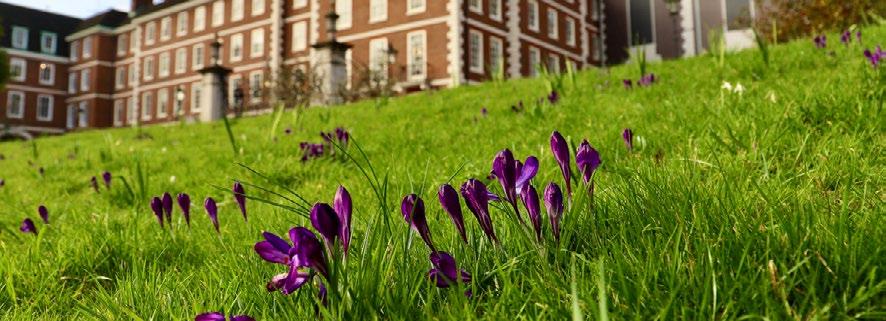
4 minute read
Garden
Early Spring

Sean Harkin, Head Gardener
Crocus ‘Ruby Giant’ in meadow
It was with great pride that I shared our special garden, as part of this year’s Kew Lecture series, in a talk I delivered in February, titled Tales of the City:
Revealing London’s Secret Garden. It opened with a brief history of the garden, followed by a short account of my horticulture journey before the Inn, before going on to share our vision for the garden and the projects we have been working on in the three years since I took over as Head
Gardener. The lecture was delivered online which allowed an international audience to join. Images of the garden were met with much excitement, and many from around the world expressed their wish to visit. For those that missed it, I recorded the talk again for the Inn which can be viewed at
innertemple.org.uk/garden
During the lecture, I recall retired
Curator of RHS Wisley, Jim Gardiner’s vision for Wisley. Alongside building one of the world’s greatest plant collections, his vision was for Wisley to be a garden for 365 days of the year and for there to be something spectacularly beautiful to enjoy in the garden every single day. This is something that stayed with me from my trainee days and as part of the vision for The Inner Temple we wish to extend the seasonal interest so that every day in the garden has something special to lift one’s spirits.
As part of this plan, we have been working on a project which entails bulb planting to create an early spring bulb meadow that sweeps down the grassy bank as one comes through the Main
Gates. It will take several years to build

Chinodoxa ‘Pink Giant’.in meadow
the layers of bulbs coming through from January till May, in the large swathes that will create the ‘tapestry’ that we wish to achieve.
Starting the show are the snowdrops (Galanthus) and winter aconites (Eranthis), quickly followed by the pale species Crocus tomassianus and slightly later darker form, Crocus tomassinanus ‘Ruby Giant’. Impressively, the snowdrops and aconites can take any weather (snow, wind and rain) that is thrown at them and this year was no exception. Other bulbs such as the crocus are slightly more delicate and can flatten in adverse conditions, in addition to the pigeons that enjoy snacking on the emerging buds.
This year we trialled some small drifts of Iris reticulata in the meadow. The earlier, deep purple variety, Iris ‘Pauline’ has long delicate stems that didn’t enjoy the adverse weather we received when she

Iris ‘Katherine Hodgkin’ in meadow

appeared. Though the translucent blue Iris ‘Katherine Hodgkin’, that appeared a couple of weeks later (when the weather was not as bad) had a stockier stem, making her less sensitive to the weather. The miniature Iris need some sun when they emerge, but we observed that the ‘Katherine Hodgkin’ lasted longer when she was not in direct sun.
The pale blue of ‘Katherine Hodgkin’ complements the early Narcissus that emerge to join her. Naricssus ‘Topolino’ (Italian for ‘Little Mouse’ or ‘Mickey Mouse’), is one of my favourite earlies. I love its pale flowers and small nodding classic daffodil shaped head. We will be building up greater numbers of this in autumn with our annual bulb planting. Those who are observant will notice that ‘Topolino’ looks very similar to the heritage variety ‘WP Milner’ which is also planted

Narcissus bulbocodium ‘Artic Bells’ in pot by sundial Narcissus ‘Topolino’ in meadow
in the meadow but comes up a couple of weeks later in mid to late March.
Alongside Narcissus ’Topolino’, the Chinodoxa (translating to ‘Glory of the Snow’ in Greek) start to flower around the same time. The pale pink stars of Chinodoxa forbesii ‘Pink Giant’ has now been reclassified into Scilla, though I’m holding onto its old name. It flowers for a number of weeks and despite being called ‘Pink Giant’ grows to a height of just 10cm. Chinodoxa/ Scilla forbesii is native to Western Turkey where it grows up to 8,000 ft, up to the snowline. Many of our favourite early flowering bulbs are Alpines, where in nature they take advantage of the melting snow and rising temperatures but are thankfully adaptable to our garden conditions.
I’ll leave you with one of the most delicate beauties that also emerges at this time. Narcissus bulbocodium ‘Artic Bells’ is known as the ‘hoop-petticoat daffodil’. She is native to the west of France, Spain, Portugal and Morocco growing in a variety of situations from near sea-level in France and Portugal to over 9,800 ft in the High Atlas Mountains in Morocco. ‘Artic Bells’ is the same as the species though paler, which we find more elegant. This year we grew her in small terracotta pans to place at key spots to be enjoyed up close. Once she had finished flowering, we planted the bulbs into the meadow, hoping she can mimic her conditions in nature to seed and spread.
It will not come as a surprise that Spring comes out in a poll as the favourite season among the Garden Team. There is a freshness and vitality that is hard to beat. After Winter (and a very wet one at that!) every individual flower that joins the lengthening days are a joy. We feel any planting that helps to bring forward the joy of this season as early as possible is very welcome. The team and I hope you enjoy watching our tapestry of early season bulbs build and develop over the coming years.







